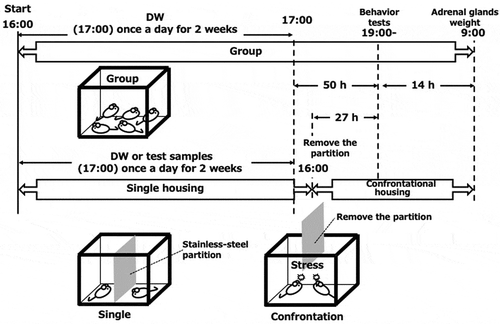ABSTRACT
Matcha has high contents of theanine, caffeine, and epigallocatechin gallate (EGCG). Among these, theanine reduces psychological and physiological stress responses, although this effect is disturbed by caffeine and EGCG. It was reported that the continued ingestion of high-quality matcha, whose molar ratio of caffeine and EGCG to theanine and arginine was kept at less than two, reduces stress responses. However, most matcha on the market has an inadequate ratio. Therefore, we investigated the influence of continued ingestion of matcha with a ratio of over two, on emotional behaviors after stress. Continued ingestion of matcha was suggested to reduce the anxiety-like behaviors induced by psychological and physiological stresses.
Graphical abstract
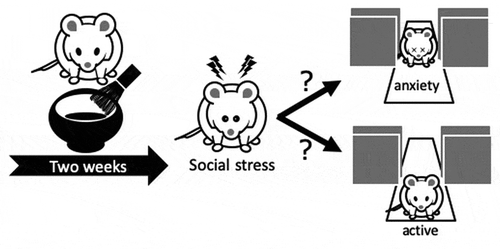
Continued ingestion of matcha may reduce the anxiety-like behaviors induced by social stress.
Psychosocial stress increases the risk for both somatic and psychiatric diseases [Citation1,Citation2]. To live a healthier life in stressful modern society, functional food and its ingredients have recently become widely used. Matcha is made from tea leaves (Camellia sinensis L.) called Tencha, which has been cultivated under shade for over 20 days before harvesting. Matcha is made by finely grinding the Tencha with a specific mill. Matcha is abundant in epigallocatechin gallate (EGCG), caffeine, and amino acids (especially theanine). Theanine is well known for reducing psychological and physiological stress responses evaluated by measuring salivary alpha-amylase and alpha-brain waves in human volunteers [Citation3,Citation4]. According to previous reports, it is required to take 200 mg of theanine at a time to obtain these effects. However, it is difficult to take this amount of theanine at a time from matcha drink or food. Recently, Unno et al. [Citation5,Citation6] found that epigallocatechin (EGC) and arginine work cooperatively with theanine, but caffeine and EGCG inhibit the effect of theanine. The authors noticed that a theanine-rich extract from green tea such as Gyokuro with lowered caffeine and EGCG had reducing effects of stress responses such as adrenal hypertrophy in mice. Moreover, Unno et al. [Citation7] reported that the continued ingestion of matcha with a molar ratio of caffeine and EGCG to theanine and arginine less than two reduces the stress responses related to anxiety in human.
The theanine content of matcha varies greatly according to the grade and is abundantly contained in the high grade [Citation8]. The theanine content of matcha is over 1% (w/w, dry weight) and exceeds 3% at the highest. On the other hand, the caffeine and EGCG contents in matcha are not related to grades. The caffeine and EGCG contents in matcha are about 4% (w/w, dry weight) and 6–7% (w/w, dry weight), respectively. Most matcha whose molar ratio is less than two are in the higher-grade range.
In the present study, we investigated the influence of continued ingestion of matcha on emotional behaviors related to anxiety after stress procedures in accordance with Unno et al. [Citation5,Citation6].
Materials and methods
Tea samples
Matcha and low-caffeine matcha were provided by Kyoeiseicha Co., Ltd. (Osaka, Japan). Matcha is a specific green tea powder feasible to drink as a thick suspension with high content of whole tea leaves. Briefly, specific green tea leaves were used, which were harvested after shading for several weeks in May as the first harvest in a year. Decaffeination using hot water was performed just for low-caffeine matcha. Those tea leaves were steamed and dried and obtained Tencha, then removed leaf vain and finely powdered to produce matcha powder. A sencha extract powder (DG-SP100), a lyophilized powder of hot-water extracted sencha green tea, was obtained from Nikken Food Co., Ltd. (Shizuoka, Japan). Sencha is a common Japanese green tea, harvested without shading, then steamed and dried with kneading, and used for hot water extraction.
Catechin and caffeine
The catechin and caffeine contents of the tea powders were measured using an HPLC system in accordance with previous reports [Citation9]. Briefly, “Matcha” (5.0 mg) and “low-caffeine matcha” (5.0 mg) were suspended in 300 µL of distilled water (DW). “Sencha extract” (1.1 mg) was dissolved in 300 µL of DW. The 0.45 µm filtration of the supernatants (DISMIC-13-HPPTFE, ADVANTEC TOYO Co., Ltd., Tokyo, Japan) was performed diluted with water, and 20 µL of each solution was injected into the HPLC system (LC-10ADvp, Shimadzu, Kyoto, Japan) with a reverse-phase column (C18-5, i.d. 4.6 × 150 mm, Fujifilm Wako Pure Chemical Co., Ltd., Osaka, Japan), a guard column (Wakopak Navi C18-5, i.d. 4.6 × 10 mm, Fujifilm Wako Pure Chemical Co., Ltd.) and UV detector. The solution was then eluted as described next at a flow rate of 1 mL/min and column temperature 40°C. HPLC analysis was performed using a linear gradient composed of mobile phase A (H2O: acetonitrile: H3PO4 = 400: 10: 1 (v/v/v)) and mobile phase B (methanol: mobile phase A = 1: 2 (v/v)). The eluates were quantified using the external standard method. Linear gradient elution was performed as follows: 5% mobile phase B for the first 2 min, programmed to 80% mobile phase B over 2–27 min, maintained at 80% mobile phase B for 27 × 35 min; and finally, back to 5% mobile phase B. Epicatechin (EC), catechin (+C), EGCG, gallocatechin gallate (GCG), epicatechin gallate (ECG), and catechin gallate (CG) were measured at 272 nm, and EGC and gallocatechin (GC) were measured at 242 nm.
Free amino acids
For the analysis of free amino acids, 100 mg of matcha and low-caffeine matcha were extracted with 10 mL of distilled water at 80°C for 30 min. The filtrate was injected into the HPLC system (LC-20AD, RF-20A XS, Shimadzu) connected to an auto-injector (SIL-30AC, Shimadzu) [Citation8]. A pre-column derivatization method, using o-phthalaldehyde, was employed and the instrument manufacturer guidelines were followed. A reverse-phase column (Inertsil ODS-4, 3 μm, 4.6 mm × 150 mm, GL Sciences, Tokyo) was employed. Mobile phases A and B were 20 mM potassium phosphate buffer (pH 6.4) and a water/acetonitrile/methanol (15/45/40 v/v/v) mixture, respectively. Linear gradient elution was performed as follows: 14% mobile phase B for the first 3 min, programmed to 35% mobile phase B for 3–15 min; 40% mobile phase B for the next 0.5 min, maintained at 40% mobile phase B for 4 min; and finally, back to 14% mobile phase B. Aspartic acid (Asp), glutamic acid (Glu), asparagine (Asn), serine (Ser), glutamine (Gln), arginine (Arg), theanine, and γ-aminobutyric acid (GABA) were analyzed with glycylglycine as an internal standard.
Animals
Four-week-old male ddY mice purchased from Japan SLC Inc. (Shizuoka, Japan) were maintained in an environmentally controlled room (24°C, 60% relative humidity, 12-h light/dark cycle with lights on from 7:00 to 19:00 h.). Food (CRF-1, Oriental Yeast co. ltd., Tokyo, Japan) and water were available ad libitum. At the end of the experimental period, mice were sacrificed under isoflurane anesthesia, and the adrenal glands were weighed.
All mice were handled in accordance with law No. 105 and the environmental ministerial notification No. 88 of the government of Japan, and the ethical committee on animal experiments of NARO institute approved the study protocol in advance (No. 2018–01).
Psychosocial stress
Acute psychosocial stress was given to mice in accordance with a previous report [Citation10]. Four-week-old mice were housed in a group of five in a cage (group) for 7 days for adaptation. The mice were then divided into two groups: Confrontationally housed and group housed. For confrontational housing, a cage was divided into two identical subunits using a stainless-steel partition. Two mice were housed in a partition cage for 2 weeks (single housing); then the partition was removed to expose the mice to confrontational stress for 27 h (confrontational housing) before behavioral tests (). Each cage was placed in a Styrofoam box in order to avoid social contact between cages.
Ingestion of tea in mice
“Matcha” (5.0 mg) and “low-caffeine matcha” (5.0 mg) were suspended in 300 µL of DW. “Sencha extract” (1.1 mg) was dissolved in 300 µL of DW. Mice from single housing were administered 300 µL of either test solution or DW via an orogastric tube once a day (17:00) for 2 weeks during a single housing period. Mice in the group housing were also administered 300 µL of DW for 2 weeks. shows the caffeine, catechin, and amino acid contents in test solutions.
Table 1. Caffeine, catechin, and amino acid contents in the test solutions.
During confrontational stress, the test solutions were not administered to mice (). Open-field and elevated plus-maze tests were performed at 27 and 28 h, respectively, after the start of confrontational stress. At the end of the experimental period, mice were sacrificed, and adrenal glands were weighed.
Open-field test
The open-field apparatus was constructed of grey vinyl chloride and measured 50 × 55 cm with 30 cm walls. A CCD camera attached to a PC computer was fixed above the apparatus. Mice were carried to the test room in their home cages. After 30 min, mice were placed into the center of the open-field apparatus individually and allowed to explore the apparatus for 5 min. After the 5-min test, mice were returned in their home cages and the apparatus was cleaned with water. We analyzed rearing behavior, total distance traveled, and a center square duration in the open field from the recorded video using a behavior analysis system (LimeLight, Actimetrics, USA). The center square was 16 central parts in the open field divided into eight segments across both the length and breadth (). The center duration is the time mice spent in the center area. Differences among the five groups were tested using the Tukey–Kramer posthoc test after one-way ANOVA.
We measured the frequency of standing using their hind legs in the open field as rearing behavior. If rearing was observed in a unit for 5 s, we counted it as 1; if it was not observed, we counted this as 0. We added up the score for each minute and assumed the occurrence frequency (maximum frequency 12). Means were compared using the Tukey–Kramer posthoc test after two-way ANOVA.
Elevated plus-maze test
We carried out an elevated plus-maze test after an open-field test. The elevated-plus-maze apparatus was constructed of grey vinyl chloride and comprised of two open arms (30 × 5 × 0.5 cm) across from each other and perpendicular to two closed arms (30 × 5 × 12 cm) with a center platform (5 × 5 × 0.5 cm) (). The open arms had very small (0.5 cm) walls to decrease the number of falls, whereas the closed arms had high (12 cm) walls to enclose the arm. The apparatus was 55 cm above the floor. A CCD camera attached to a PC computer was fixed above the apparatus. Mice were placed into the closed arm of the elevated-plus-maze individually and allowed to explore the apparatus for 10 min. After the 10-min test, mice were returned in their home cages and the apparatus was cleaned with water. We measured the total distance traveled and the time spent in each arm and center using a behavior analysis system (LimeLight, Actimetrics, USA). Means were compared using the Tukey–Kramer posthoc test after one-way ANOVA. These behavior tests were performed between 19:00 and 22:00.
Results
Contents of caffeine, catechins, and amino acids in the test solutions
shows the caffeine, catechin, and amino acid contents in test suspension. The molar ratios of (caffeine+EGCG)/(theanine+arginine) of “matcha”, “low-caffeine matcha” and “sencha extract” were 3.2, 2.2 and 4.9, respectively. The molar ratios of all test samples are over two, which was expected not to have an anti-stress effect [Citation7]. Caffeine intake from “matcha” was about 200 µg/30–35 g body weight (4–6 mg/kg b.w.) which is the dose that the onset of sleep is delayed for 60–90 min when mice take caffeine just before they sleep [Citation11].
Open-field test
The open-field test is an experimental test used to measure locomotor activity levels, anxiety, and willingness to explore in rodents. The decrease in the time spent in the center area was judged as an increase in anxiety-like behaviors.
The open-field test was performed 27 h after the start of confrontational stress. First, we measured total distance traveled during 5 min in a novel arena. There was no significant difference in total distance traveled among the five groups ()). Next, we analyzed the proportion of time spent in the center area. The proportion in the confrontational stress groups was decreased but not significant ()).
Figure 3. Total distance traveled and the rate of the time spent in the center area in an open-field arena DW, distilled water; S, sencha; M, matcha; LM, low-caffeine matcha. Means±SE (n= 8–10). There is no significant difference. Differences among the five groups were tested using the Tukey–Kramer posthoc test after one-way ANOVA.
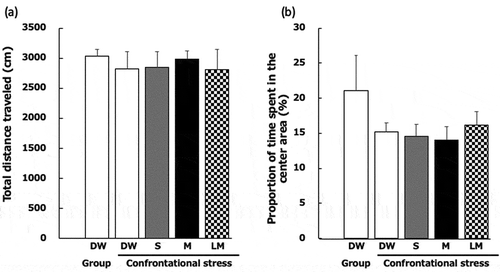
Moreover, we measured rearing behavior in the open-field arena. The rearing frequency in the “group” and “confrontational stress + matcha” groups was maintained at about 10 during a measuring time of 5 min (); however, the rearing frequency of the others occurred at a lower frequency. The rearing frequency of the “confrontational stress + DW” group was significantly decreased compared with the “group” group.
Figure 4. Rearing frequency in the open-field arena If rearing was observed in a unit for 5 s, we counted it 1; if it was not observed, we counted it 0. We added the score up every minute and assumed this as the occurrence frequency (maximum frequency 12). ○, Group + DW; ●, Confrontational stress + DW; Δ, Confrontational stress + matcha; ■, Confrontational stress + sencha; ´, Confrontational stress + low-caffeine matcha. Means±SE. Differences among the five groups were tested using the Tukey–Kramer posthoc test after two-way ANOVA. Statistical significance was accepted at p < 0.05 (n= 8–10). Significant differences are shown by different letters (a, b).

Elevated plus-maze test
The elevated plus-maze test, which is one of the most widely used to assess anxiety-like behaviors, is based on two conflicting innate tendencies to explore a novel environment and avoid elevated-open spaces. The decrease in the time spent exploring the open-arms and center indicates the anxiety level of the animal.
The elevated plus-maze test was performed for 10 min at 28 h after the start of confrontational stress. First, we measured the distance traveled divided into the first 5 min and the last 5 min during a measuring time of 10 min. The distance covered in all groups in the last 5 min decreased compared with that in the first 5 min, but there was no significant difference among all groups ().
Figure 5. Total distance traveled in the elevated plus-maze test. The results were analyzed after dividing into the first 5 min and the last 5 min during a measuring time of 10 min. DW, distilled water; S, sencha; M, matcha; LM, low-caffeine matcha. Means±SE (n= 8–10). There is no significant difference. Differences among the five groups were tested using the Tukey–Kramer posthoc test after one-way ANOVA.
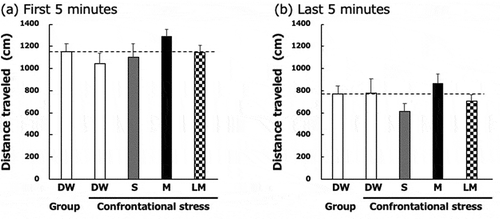
Next, we measured the proportion of time spent in the open-arms and center. The proportion of time spent for the first 5 min was not significantly different among all groups, but for the last 5 min the rate of time spent of all groups except for the “confrontational stress + matcha” group decreased (). In particular, the decrease in the “confrontational stress + sencha” group was notable. Hence, there was a significant difference between the “confrontational stress + matcha” and “confrontational stress + sencha” groups.
Figure 6. Rate of time spent in the open arms of the elevated plus-maze test. The results were analyzed after dividing into the first 5 min and last 5 min during a measuring time of 10 min. DW, distilled water; S, sencha; M, matcha; LM, low-caffeine matcha. Means±SE. Differences among the five groups were tested using the Tukey–Kramer posthoc test after one-way ANOVA. Statistical significance was accepted at p < 0.05 (n= 8–10). Significant differences are shown using different letters (a, b).
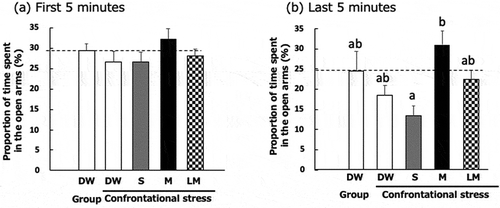
Weight of adrenal gland
We measured the weight of adrenal glands at 41 h after the start of confrontational stress. The weights of adrenal glands in the stress groups were moderately increased, but there was no significant difference between the “group” and “stress group” groups (). In a previous study [Citation10], maximization time of the adrenal gland by confrontational stress was 24 h after stress load. After this, the weight of adrenal glands recovered gradually. The adrenal glands in this study were measured 41 h after stress; hence, it was considered that noticeable hypertrophy has not been detected. In addition, the weights of adrenal glands of the “group” in this study were slightly larger than that of the “group” in the previous study [Citation10] in which the test samples were provided ad libitum. The slightly larger adrenal glands of the “group” in this study may be the effect of stress by orogastric tube administration.
Table 2. Weight of adrenal glands (mg).
Discussion
We investigated the influence of continued ingestion of matcha on emotional behaviors related to anxiety after stress procedures. The open-field test is an experimental test used to measure locomotor activity levels, anxiety, and willingness to explore in rodents. The center duration and rearing are related to an exploratory behavior in a novel environment. The decrease in the center duration is judged as an increase in anxiety-like behavior. The total distance traveled in the open-field was not different among all groups, but the proportion of the center duration in the confrontational stress groups tended to be lower compared with the non-stress group (). This decrease was considered to show behavioral suppression by the confrontational stress.
The rearing frequency which was decreased by confrontational stress recovered with the administration of “matcha” (). Moreover, in the elevated plus-maze test, the decreased time spent in the open-arm and center by the confrontational stress group was not observed in the “matcha” group ()).
The weight of adrenal glands showed some increase in the confrontational stress groups (). The stress activates hypothalamic-pituitary-adrenal (HPA) axis resulting in adrenal hypertrophy. From these results, the “matcha” seemed to reduce the stress responses such as anxiety without the attenuation of the activation of the HPA-axis.
As shown in , caffeine was present at a higher level in “matcha” compared with the other teas. On the other hand, theanine was present at similar levels in “low-caffeine matcha” and “matcha”. The previous study using an elevated plus-maze test has reported that theanine has psychotropic effects but has not anti-anxiety effect [Citation12]. Therefore, it was inferred that caffeine is related to maintain the higher frequency of rearing and the time spent in exploring open-arms after the stress load. However, behavior tests were performed 50 h after the final administration of “matcha”. Therefore, it is not reasonable that the caffeine in “matcha” acted directly.
In a previous study, anti-anxiety drugs such as benzodiazepines (agonists of the γ-aminobutyric acid (GABA) type A receptor) increased the time spent in the open-arm [Citation13]. Chronic caffeine ingestion increases GABAA receptors in the mice brain [Citation14].
It is likely that continued ingestion of matcha results in caffeine enhancing expression of the GABAA receptor complex, and as a result, there is a possibility that the anxiety-like behavior induced by the stress was decreased. It is necessary to continue further analysis on the influence of the coexistence of theanine and EGCG.
Conclusion
There was a very limited possibility that matcha, in which the molar ratio of (caffeine + EGCG)/(theanine + arginine) is over two, has an anti-stress effect. However, there is another possibility that such matcha reduces anxiety behaviors induced by stress.
Author contribution
M.M., S.N., K.E., and H.H. designed research; M.M. conducted the research and wrote the manuscript; and S.N., K.E., and H.H. edited the manuscript. All authors read and approved the final manuscript.
Acknowledgments
The authors are grateful to Kyoeiseicha Co. Ltd. which has provided the matcha and low-caffeine matcha. The authors would like to express their gratitude to ling Co., Ltd for supporting us with the use of the behaviors analysis system.
Disclosure statement
No potential conflict of interest was reported by the authors.
References
- Thayer JF, Yamamoto SS, Brosschot JF. The relationship of autonomic imbalance, heart rate variability and cardiovascular disease risk factors. Int J Cardiol. 2010;141(2):122–131.
- Donner J, Sipilä T, Ripatti S, et al. Support for involvement of glutamate decarboxylase 1 and neuropeptide Y in anxiety susceptibility. Am J Med Genet B Neuropsychiatr Genet. 2012;159B(3):316–327.
- Kobayashi K, Nagato Y, Aoi N, et al. Effects of L-theanine on the release of a-brain waves in human volunteers. Nippon Nogeikagaku Kaishi. 1998;72(2):153–157.
- Unno K, Tanida N, Ishii N, et al. Anti-stress effect of theanine on students during pharmacy practice: positive correlation among salivary α-amylase activity, trait anxiety and subjective stress. Pharmacol Biochem Behav. 2013;111:128–135.
- Unno K, Hara A, Nakagawa A, et al. Anti-stress effects of drinking green tea with lowered caffeine and enriched theanine, epigallocatechin and arginine on psychosocial stress induced adrenal hypertrophy in mice. Phytomedicine. 2016;23(12):1365–1374.
- Unno K, Yamada H, Iguchi K, et al. Anti-stress effect of green tea with lowered caffeine on humans: A pilot study. Biol Pharm Bull. 2017;40(6):902–909.
- Unno K, Furushima D, Hamamoto S, et al. Stress-reducing function of matcha green tea in animal experiments and clinical trials. Nutrients. 2018;10(10):1468.
- Horie H, Ema K, Sumikawa O. Chemical components of matcha and powdered green tea. J Cookery Sci Jpn. 2017;50(5):182–188.
- Maeda-Yamamoto M, Nagai H, Suzuki Y, et al. Changes in O-methylated catechin and chemical component contents of ‘Benifuuki’ green tea (Camellia sinensis L.) beverage under various extraction conditions. Food Sci Tech Res. 2005;11:248–253.
- Unno K, Iguchi K, Tanida N, et al. Ingestion of theanine, an amino acid in tea, suppresses psychosocial stress in mice. Exp Physiol. 2013;98(1):290–303.
- He RR, Xie G, Yao XS, et al. Effect of cocoa tea (Camellia ptilophylla) co-administrated with green tea on ambulatory behaviors. Biosci Biotechnol Biochem. 2009;73(4):957–960.
- Wakabayashi C, Numakawa T, Ninomiya M, et al. Behavioral and molecular evidence for psychotropic effects in L-theanine. Psychopharmacology (Berl). 2012;219(4):1099–1109.
- Lister RG. The use of a plus-maze to measure anxiety in the mouse. Psychopharmacology (Berl). 1987;92(2):180–185.
- Shi D, Nikodijević O, Jacobson KA, et al. Chronic caffeine alters the density of adenosine, adrenergic, cholinergic, GABA, and serotonin receptors and calcium channels in mouse brain. Cell Mol Neurobiol. 1993;13(3):247–261.

